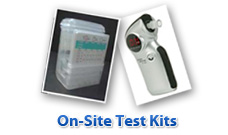Welcome!
“Mephedrone and Legal highs”: harmless fun? Or something more sinister?
The Legal Status of Mephedrone
Mephedrone was made illegal and classified as a Class B drug in the UK on April 7th 2010. Possession can lead to up to five years in prison, and supply can lead to up to fourteen years in prison and an unlimited fine.
Mephedrone Test – Testing for Mephedrone
Currently, mephedrone tests can only be carried out on the raw substance itself, or by taking a sample of hair, and having that sample tested in the laboratory. This is typically done using a 3-month sample, which requires three centimetres of hair to be taken from the scalp of the donor. This can be either a 3-month overview (which can tell whether mephedrone has been taken at some point in the last three months) or a 3-month segment review (which is more precise in terms of when the drug was actually taken). We now offer mephedrone testing (both as a mephedrone hair test and testing the raw substance) as a standard test, so please Contact Us for pricing and to get the process underway. Currently, there is no on-site Mephedrone Test available.
If you are concerned that someone may be using legal highs or other illegal drugs, please visit our drug information page for information on the signs, symptoms and effects of these substances.
Overview of Mephedrone
Legal highs have stirred significant media interest after several recent deaths amongst young people. Legal high sales have risen steadily until a recent spike in sales driven by media coverage. Many online mail-order suppliers even claim to have sold out as a result.
With almost half of the websites selling legal highs based in the UK, the European Union’s drug agency has highlighted that the UK is a hotspot for the online trade in legal highs. But with Government efforts to stem the tide, how long will this last? Certainly a point to publicise is that although a drug may currently be “legal”, this is not a real indication of safety, as many substances aren’t being used for their intended purpose – which can range from plant fertilisers to worming treatments for cattle.
With the recent media furore surrounding legal highs, and the resultant confusion around the legality, safety and detectability of legal highs, particularly Mephedrone, this article aims to inform about what is known for certain.
History of Mephedrone
Mephedrone as we know it today was synthesised by individuals in back-street laboratories. Because of this, there have been no official tests into the results of use on either animals or human beings, rendering the drug potentially life-threatening. Mephedrone was first officially recognised by boards investigating new drugs in 2008, but due to the drug’s underground origins, very little is known about the effects it can have on the human body.
Originally marketed as a legal high, mephedrone quickly came to the UK media’s attention. Mephedrone’s popularity was likely caused by the decreasing purity of ecstacy and cocaine in the UK. Media and political pressure made it necessary for the Government to review the drug. Mephedrone had already been outlawed in Israel, Sweden, Romania, Germany, Estonia, Denmark and Croatia when the UK moved to make it illegal in April 2010. Mephedrone is now a Class B controlled substance.
Tackling the Problem
Attempts to tackle the sale of legal highs is a mounting challenge for many governments – with drugs such as Mephedrone (also known as meph, 4-MMC, MCAT, Drone, Meow and Bubbles) already banned in Germany, Denmark, Sweden and Israel. Synthesised in overseas laboratories, these drugs are often designed to mimic the effects of controlled drugs such as Ecstasy, Cocaine and Amphetamines, but they currently fall outside of most drug control laws and are sold via the internet or in “headshops”, along with incense, smoking paraphernalia and other drug related “souvenirs”.
Other formerly legal highs which have now also been legislated against to make them a Class C drug include GBL (gamma-butyrolactone), an industrial solvent and BZP (benzylpiperazine, manufactured as a cattle worming treatment, sometimes called “Benny”), whose effects on the brain are very similar to Ecstasy. Synthetic cannabinoids, which are man-made chemicals sprayed on herbal smoking products such as Spice, fall into Class B of the Misuse of Drugs Act.
Despite these changes, the trade in formerly legal highs may not diminish as significantly as we might hope. Substance misuse in today’s society is certainly more common than public perception would indicate. Study data from the British crime survey carried out by the Home Office indicates that nearly half of all 16 to 29-year-olds have used an illegal drug in the last year and almost one in five 16 to 24-year-olds have used an illegal drug in the last month. When you consider young people at secondary school age, data from the NHS indicates that 27% of 15-year-olds have already used illegal drugs.
So what drives this behavior? Research into the motivation behind drug use, carried out by the Joseph Rowntree foundation, has indicated that the single largest contributory factor to drug abuse is boredom. A close second is the individual’s environment. I.e. if everybody around you is using drugs, isn’t that normal? Whilst the third leading factor is curiosity. With such mundane forces driving substance abuse, legal highs (or illegal highs) are a likely purchase for many young people as media coverage grows, and whilst they continue to be legal.
About the Author: Christopher Evans is the Technical Director of Drug-Aware Ltd, a provider of drug awareness training, laboratory services and drug and alcohol testing products to the NHS, British Police, Companies and private individuals across the UK.
Please contact us for information on mephedrone testing in the workplace, health care or at home.
Tags: Drug Awareness, Legal Highs, Mephedrone, Mephedrone Test, Mephedrone testing, Mephedrone Tests






